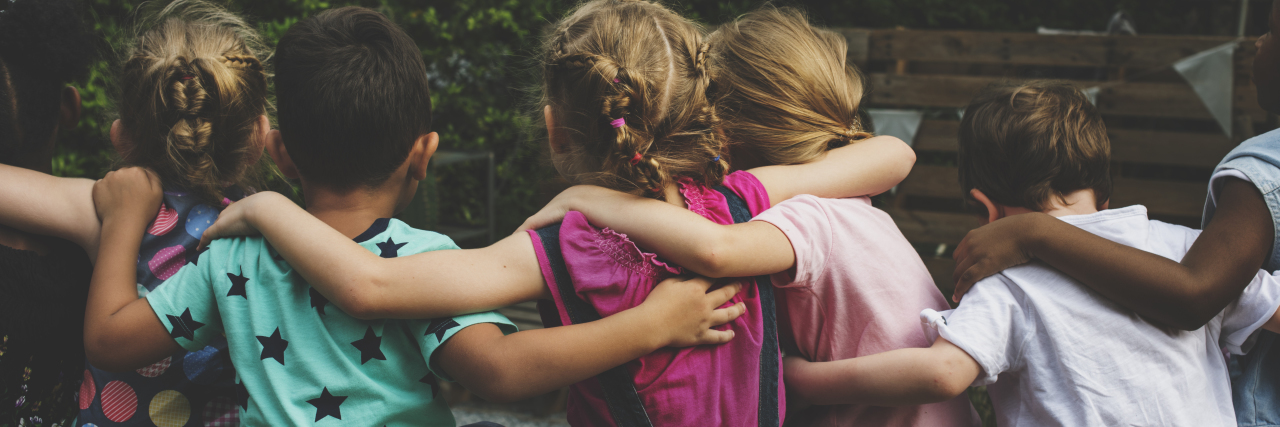I doubt any parent has said, “I want my child to grow up to be a bully.”
No parent wants that phone call saying their son or daughter has been calling other children names either.
But just because our child isn’t bullying or name-calling doesn’t mean they’re developing the compassion for others that is part of being a well-rounded young adult.
Earlier this week, I wrote about my son’s experience with being called the “R-word” and a few other choice names.
When it happened, I had to come to terms with how a teenager in this day and age, much less a teenager at an exclusive, well-respected private school, much less one with the responsibility of guiding younger kids as a day camp counselor, could grow to call another child such names. I get that we use some of these words just in descriptive parlance, or in truly joking ways, but the R-word? No, we don’t. Because it has a history, a history of discrimination and bullying.
The teenager didn’t know my son had a younger brother with cognitive challenges. He didn’t have to. That doesn’t really matter anyway.
I recognize that all children (and adults) make mistakes. We do. I do. And maybe this was one of those. My first calling is to extend grace and hope this teenager learns from the formal apology he was required to write.
But how might we all help our kids not make such mistakes? Or worse, become people who intentionally have little regard for, or about, those who have disabilities?
Parents should consciously incorporate strategies to help their kids learn to be inclusive of those with different abilities and frankly, compassionate to anyone different than them.
It’s as easy as A-E-I-O-U. And inclusion, I believe, starts with you — the parent.
A – Accept
As parents, we must show acceptance for people with disabilities in our attitude, speech, and actions. That means we don’t say the R-word, or use terms like “short bus,” etc. We speak and act in ways that show that those with disabilities, whether it be physical, cognitive, or behavioral, have just as much right to be included in society as do those with typical abilities. Whereas inclusion is traditionally seen as a concept in schools, we must practice it as adults. We shouldn’t be alarmed if a child is jumping or flailing in line at Starbucks and touches us. Maybe, instead, we try to engage them in a conversation. We speak of people who have disabilities as people first. We act in a manner that takes them into account.
E – Explain and Encourage Empathy
“E” is a popular one. We should first explain to our children about disabilities. We can use examples of people we know or have seen, in person, on television, in movies. We can also use books. We must be intentional about fostering empathy in our children, both for the experience of those with disabilities as well as our child’s interaction with them. Be frank with your child – our goal is for them to be the one befriending, defending, or assisting (if needed or asked) a child who might be different, especially if they are ever being teased or bullied, or even talked about by other kids without their knowledge.
I – Include
We should find ways to include those with disabilities in our own lives and our children’s lives. Are there children with disabilities in their class? Is your child asking them to their birthday party? Over to play? Could we volunteer at school or in church in ways that allow you to get to know families of children with disabilities so they can invest in our life and us in theirs? We should be supportive in words and actions of inclusion in our children’s schools, which then allows us opportunities to foster inclusion in their lives.
O – Opportunities
On the flip side of including those with disabilities in our child‘s life and activities, we should seek out opportunities for us and our child to participate in environments and activities where they might get together. There are opportunities along the entire continuum of a child’s development, from enrolling in public or private inclusive preschools, serving as buddies for baseball leagues (Bambino Buddy-ball or The Miracle League are two examples), assisting with disability ministries at a church, volunteering with Special Olympics (as an athlete on a unified team or at an event like a spring track and field meet), or serving as a Best Buddy, just to name a few.
U – Universal design
Universal design (UD) is a concept that generally refers to equipment being designed for people with disabilities — such as a playground with ramps and special swings. But I propose UD as a perspective on life. In our own life and our child’s life, promote and consider those of all abilities in how equipment works, how systems are designed, etc. Could someone with a wheelchair come to our house? Our church? What activities do we know that are enjoyed by those with disabilities? This is a much easier perspective once you have already involved people with disabilities in your daily life or on a regular basis. You begin to think differently. You consider life in a multi-faceted way, instead of solely from one’s own perspective, and that is a good thing.
It becomes less about “me” and more about “we.”
And isn’t that what we’re trying to teach our kids anyway?
This story originally appeared on Melissa Hogan

